This post may contain affiliate links. Please read our disclosure policy.
Craving those bakery-style cranberry orange scones? This recipe is for you. Built on my master scone base (tested for weeks!), I nailed the citrus-cranberry balance after four rounds of experimenting. I tested fresh vs. dried cranberries, adjusted flour for moisture, and dialed in the perfect amount of zest and juice.
The result? Tall, golden, flaky scones with juicy cranberry pockets and bright orange flavor—plus step-by-step tips to help you nail them at home.
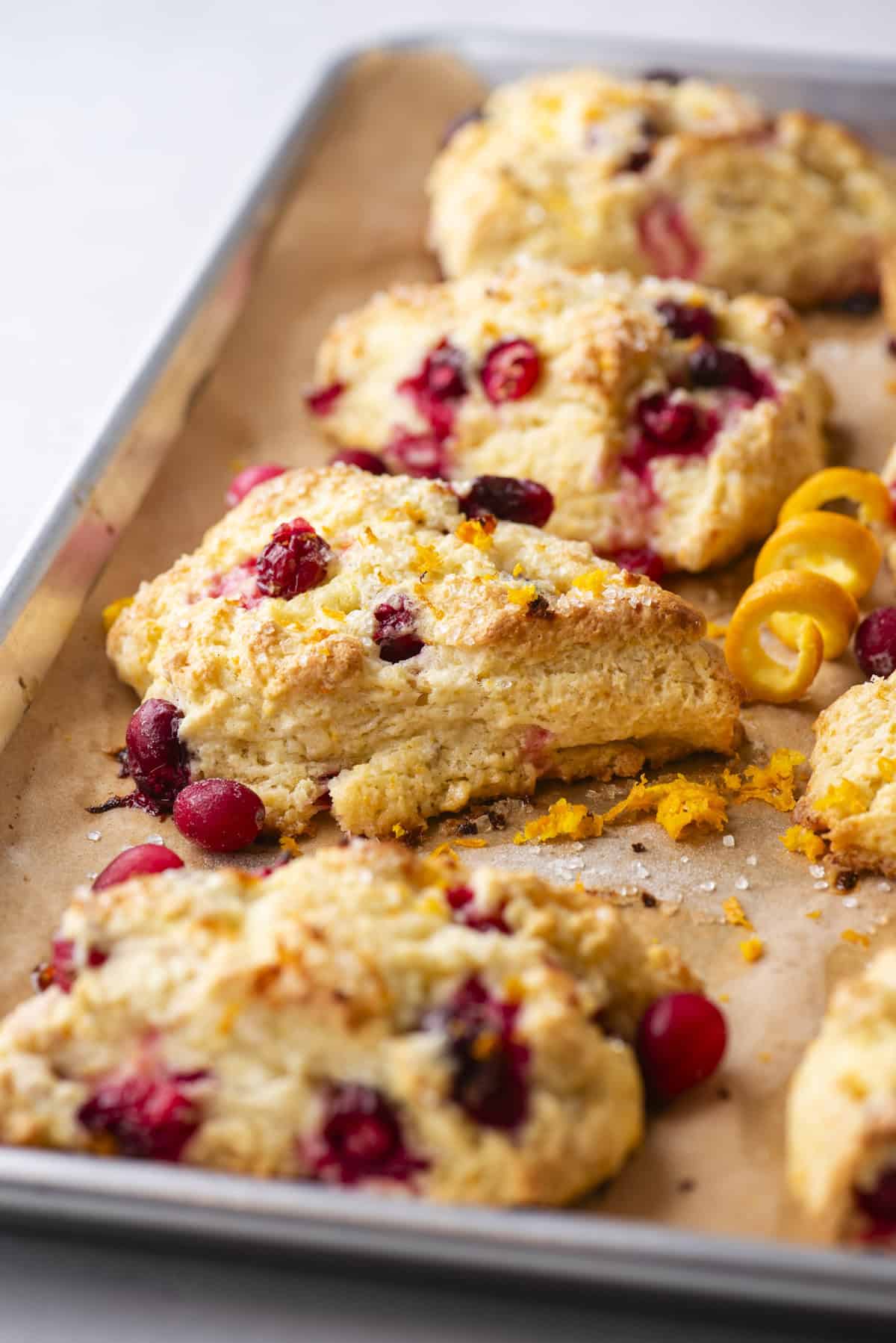
These Orange Cranberry Scones Are Better Than The Bakery
These cranberry orange scones are the result of thoughtful testing and fine-tuning, built on the same reliable base scone recipe I spent weeks developing.
I tested four different versions of this flavor combo, tweaking everything from flour ratios to mix-in balance to get them just right.
One challenge I faced? Moisture from the cranberries—especially when using fresh ones—can throw off the dough. To solve that, I added just the right amount of extra flour (¼ cup or 30g) to maintain a soft, workable dough without sacrificing flakiness.

I also tested both fresh and dried cranberries, so you have options depending on what’s in your kitchen.
For the citrus, I landed on the perfect balance: 1 tablespoon of fresh orange zest and 1 tablespoon of juice to brighten the dough without adding too much liquid. The result? Tall, golden-topped scones bursting with tart cranberries and pops of orange zest.
Whether you’re new to scone baking or looking to master a bakery-style version at home, this recipe is tested, trusted, and designed to work—because I’ve already done the legwork for you.
Why You’ll Love These Orange Cranberry Scones
- Bakery-style results at home – Tall, golden, flaky scones with juicy cranberry pockets and bright citrus flavor.
- Tested to perfection – Built on my master scone base, developed and refined over weeks of testing.
- Flavor-balanced – Four rounds of testing to get the right mix of tart cranberries and fresh orange without excess moisture.
- Cranberry options – Use fresh, frozen (no need to thaw), or dried cranberries—whatever you have on hand.
- Smart citrus ratio – 1 tablespoon each of zest and juice adds bold orange flavor without making the dough wet.
- Reliable and beginner-friendly – Step-by-step tips make this recipe easy to follow, even for first-time scone bakers.
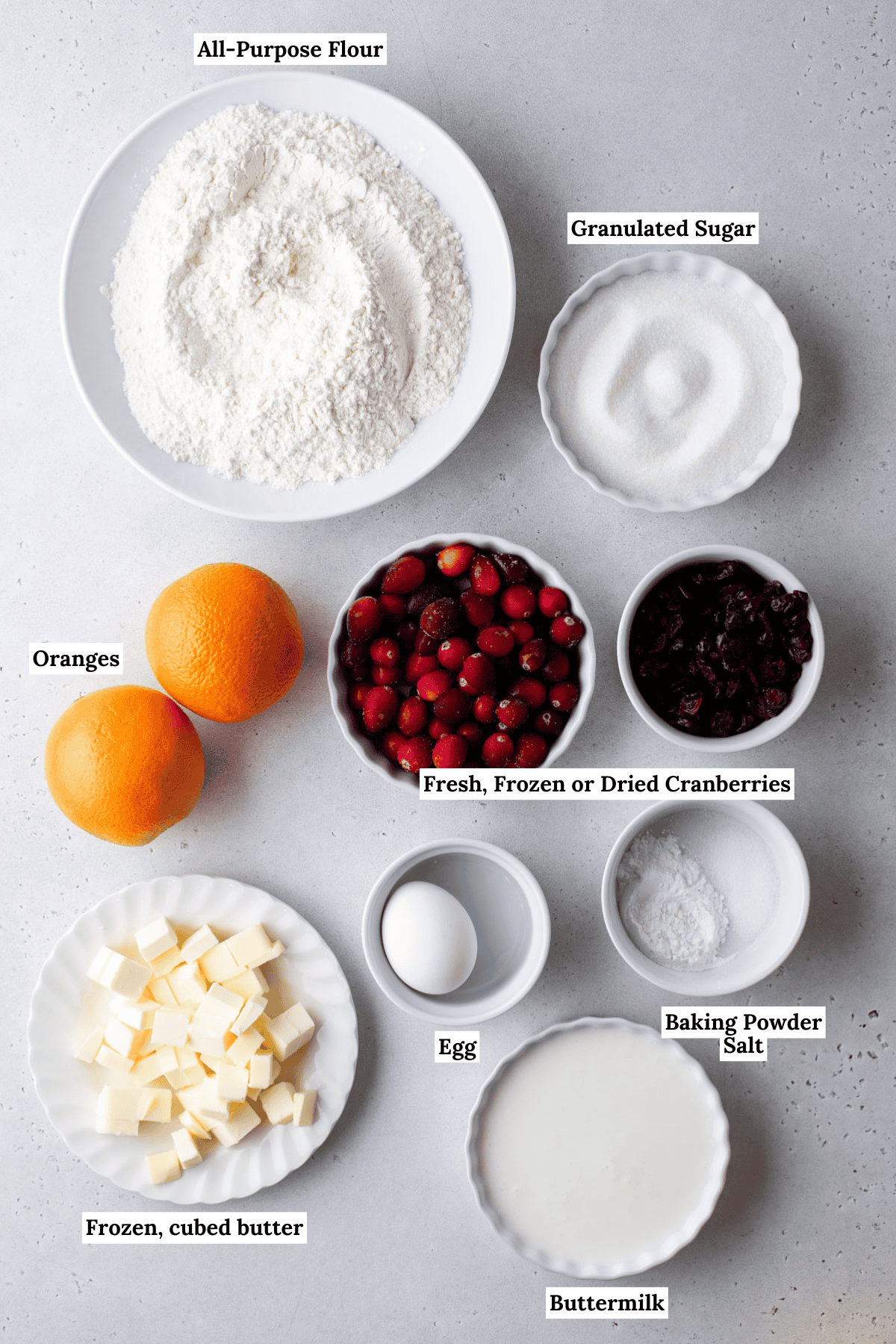
Cranberry Orange Scones Recipe Ingredients
These ingredients are key for creating bakery-style cranberry orange scones:
- All-purpose flour – In my recipe, I tweaked the flour ratio until it was just right to account for the added liquid from the orange juice. The right amount of flour is key in any baked good.
- Baking powder – In this recipe, we use 1 whole tablespoon of baking powder for lots of lift, which is key when baking tall, bakery-style scones.
- Orange zest & orange juice – Fresh orange zest and orange juice adds the citrus/orange flavor to these scones.
- Unsalted butter – For scones, the butter needs to be cubed and cold. This is crucial for creating a flaky, tender texture.
- Fresh or frozen cranberries, or dried cranberries – A key element in this recipe, the good news you can use fresh, frozen, or dried. Do not thaw frozen cranberries.

How to Make Orange and Cranberry Scones
Follow my easy step-by-step instructions to make cranberry orange scones like a pro:
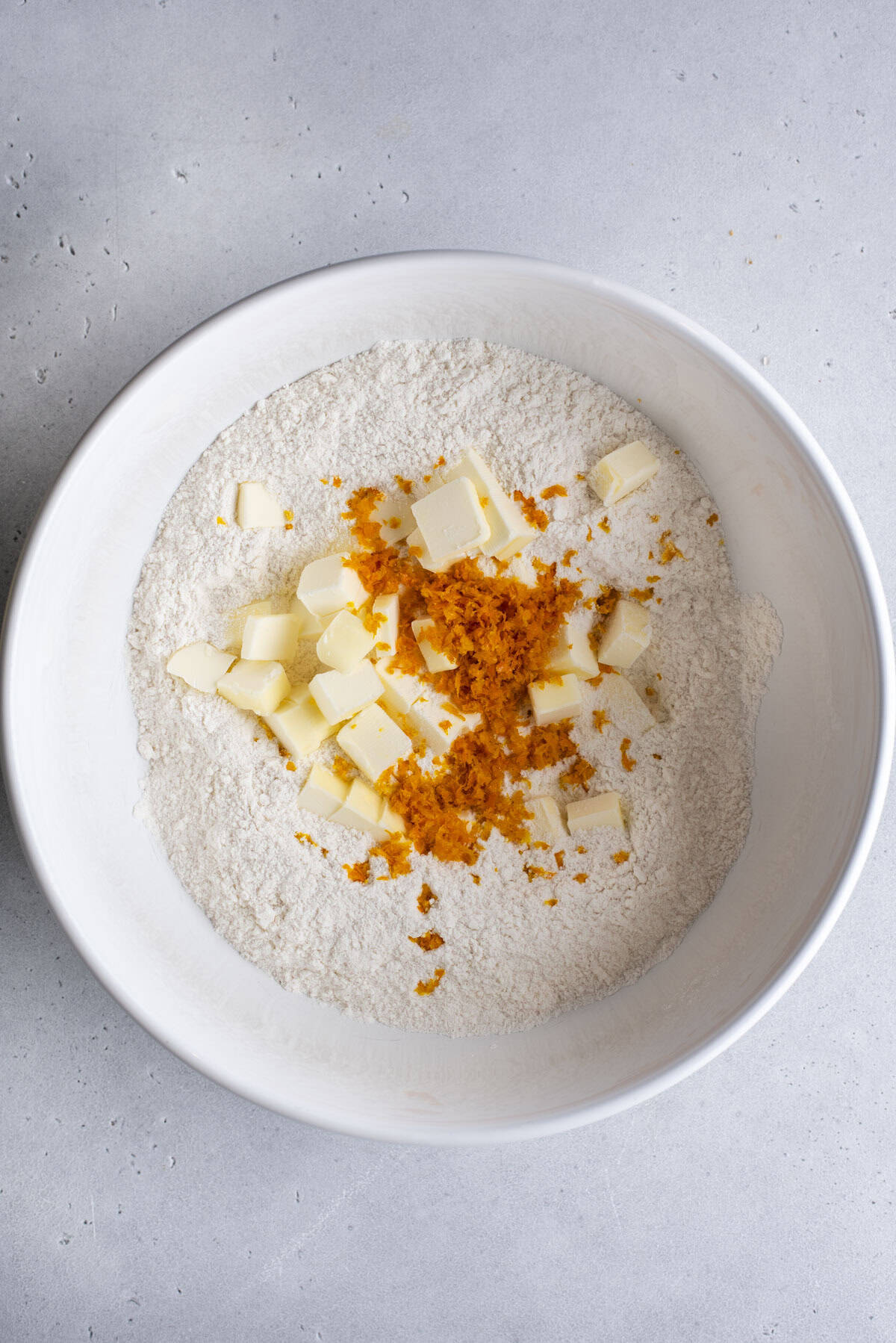
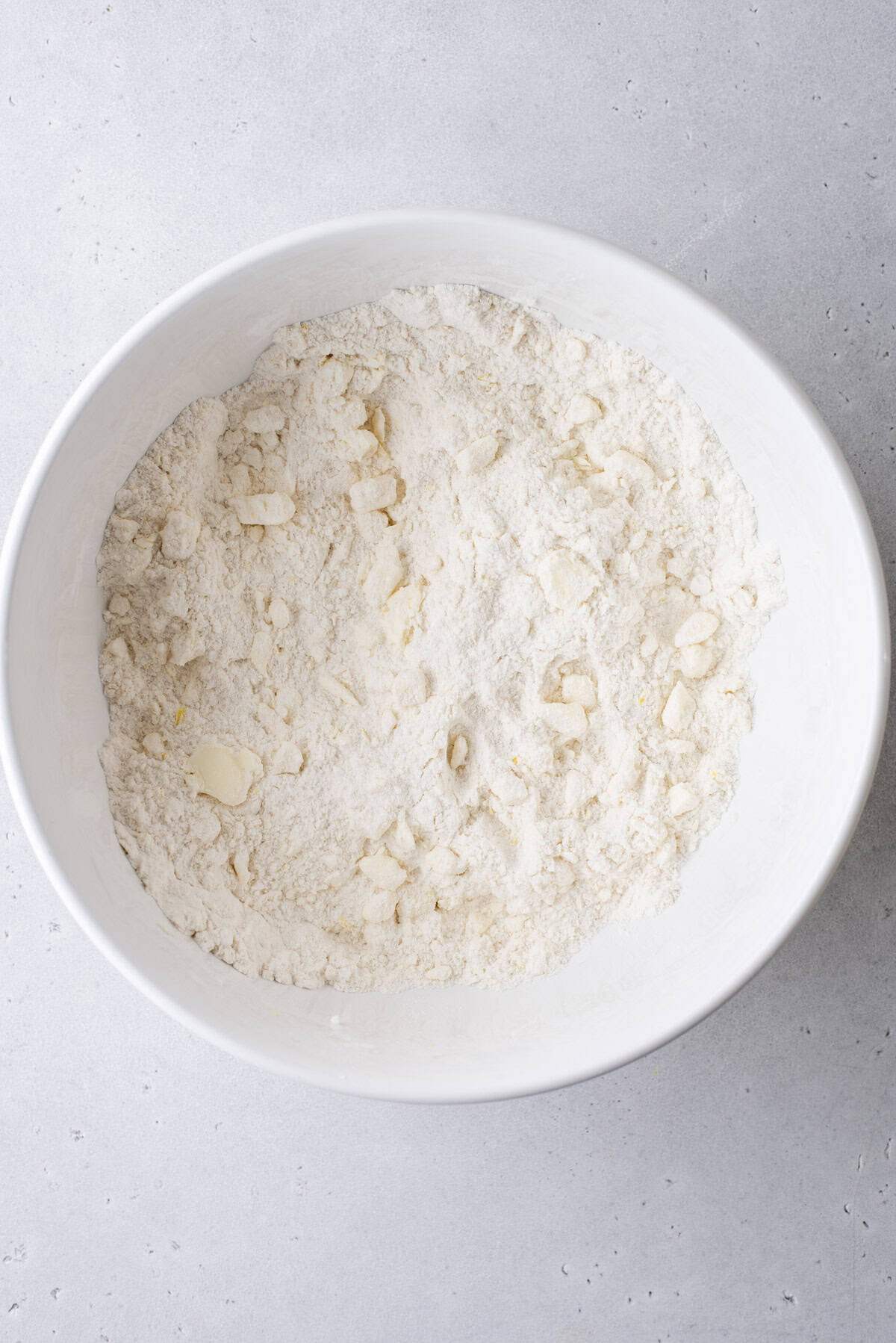
- Mix dry ingredients and cut in butter: In a large mixing bowl combine the flour, granulated sugar, baking powder, salt, and orange zest. Add in the cold, cubed butter and use your hands or a pastry cutter to cut in the butter until pea sized amounts of butter remain.
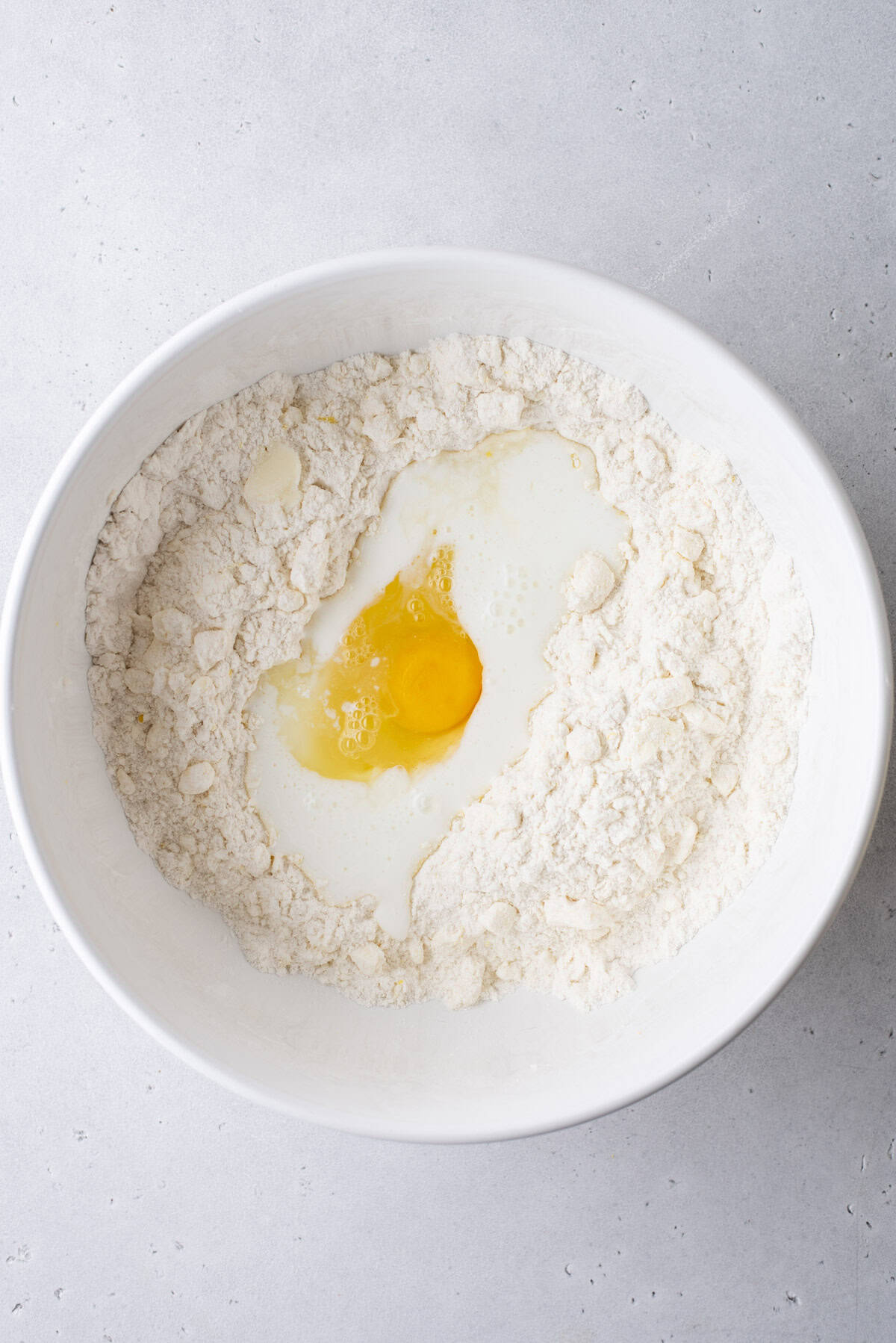
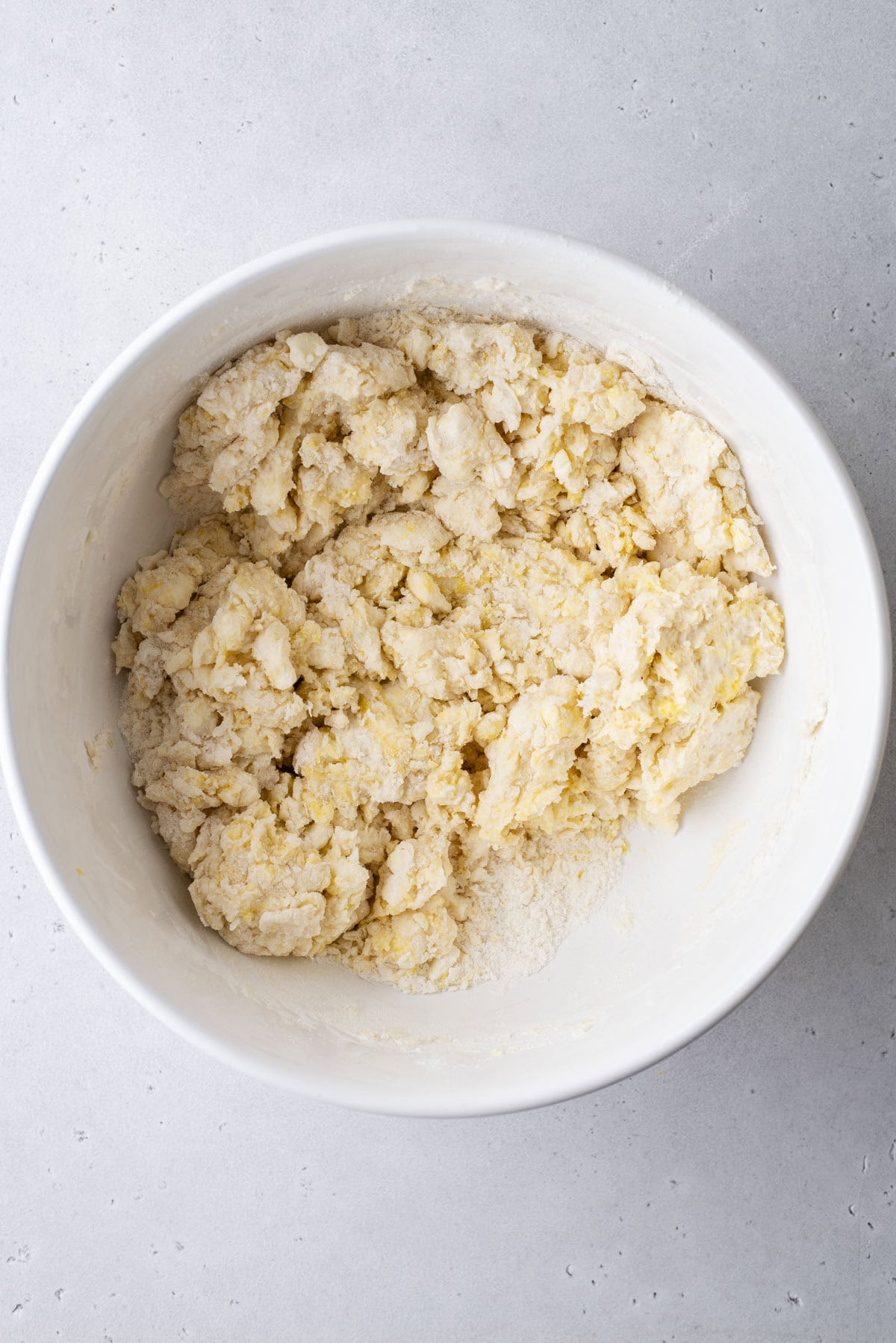
- Mix in wet ingredients: Create a well in the center of the flour mixture. Add the buttermilk, orange juice, and egg. Use a spatula to gently combine until the dough is thick and sticky. Gently stir in the fresh or frozen cranberries (do not thaw), or dried cranberries.
- Knead dough: On a silicone mat or kitchen counter, gently knead the dough, until all the flour is incorporated.
- Adjust as needed: Add 1-2 additional tablespoons of flour if the dough is too sticky.
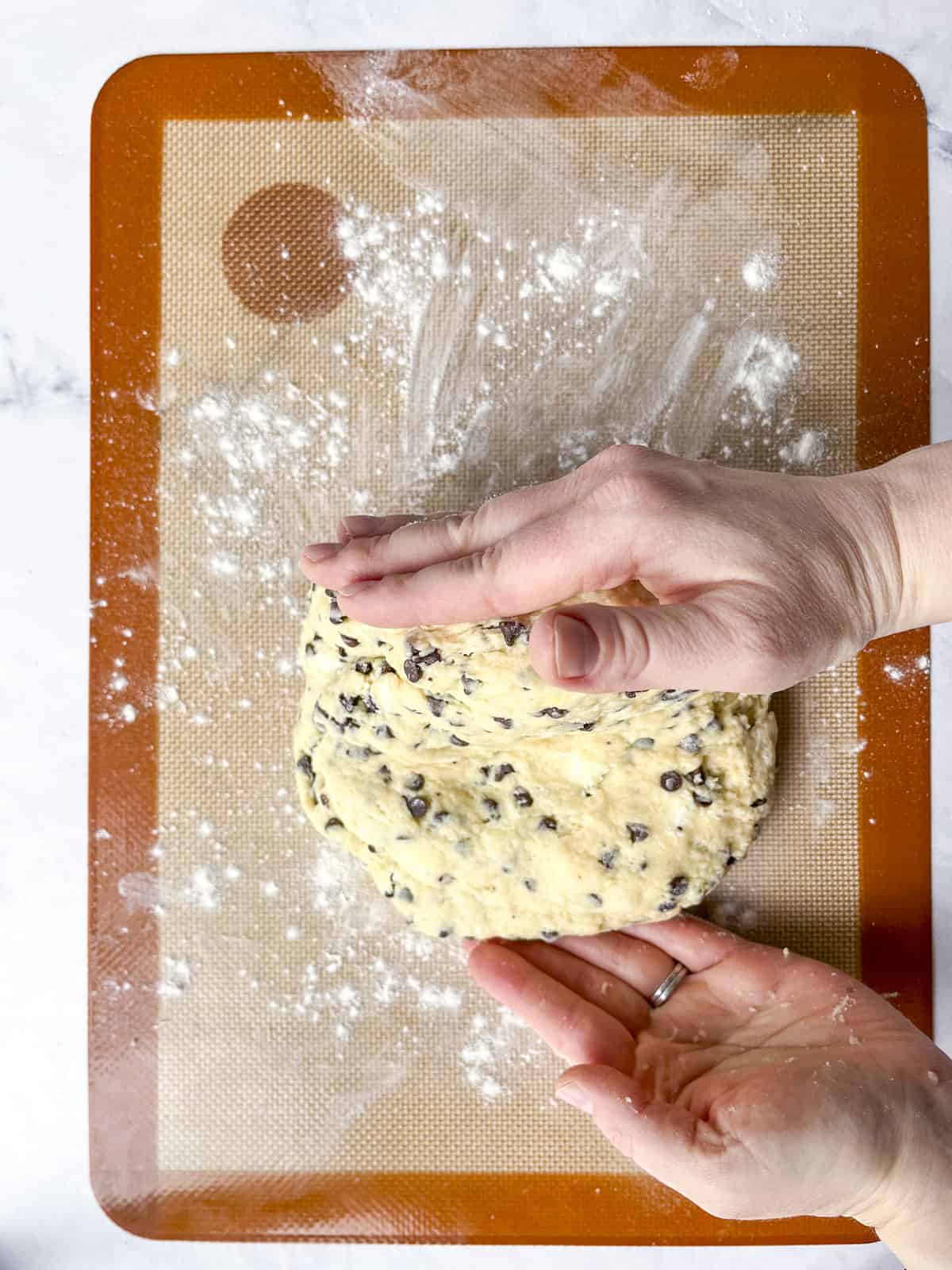
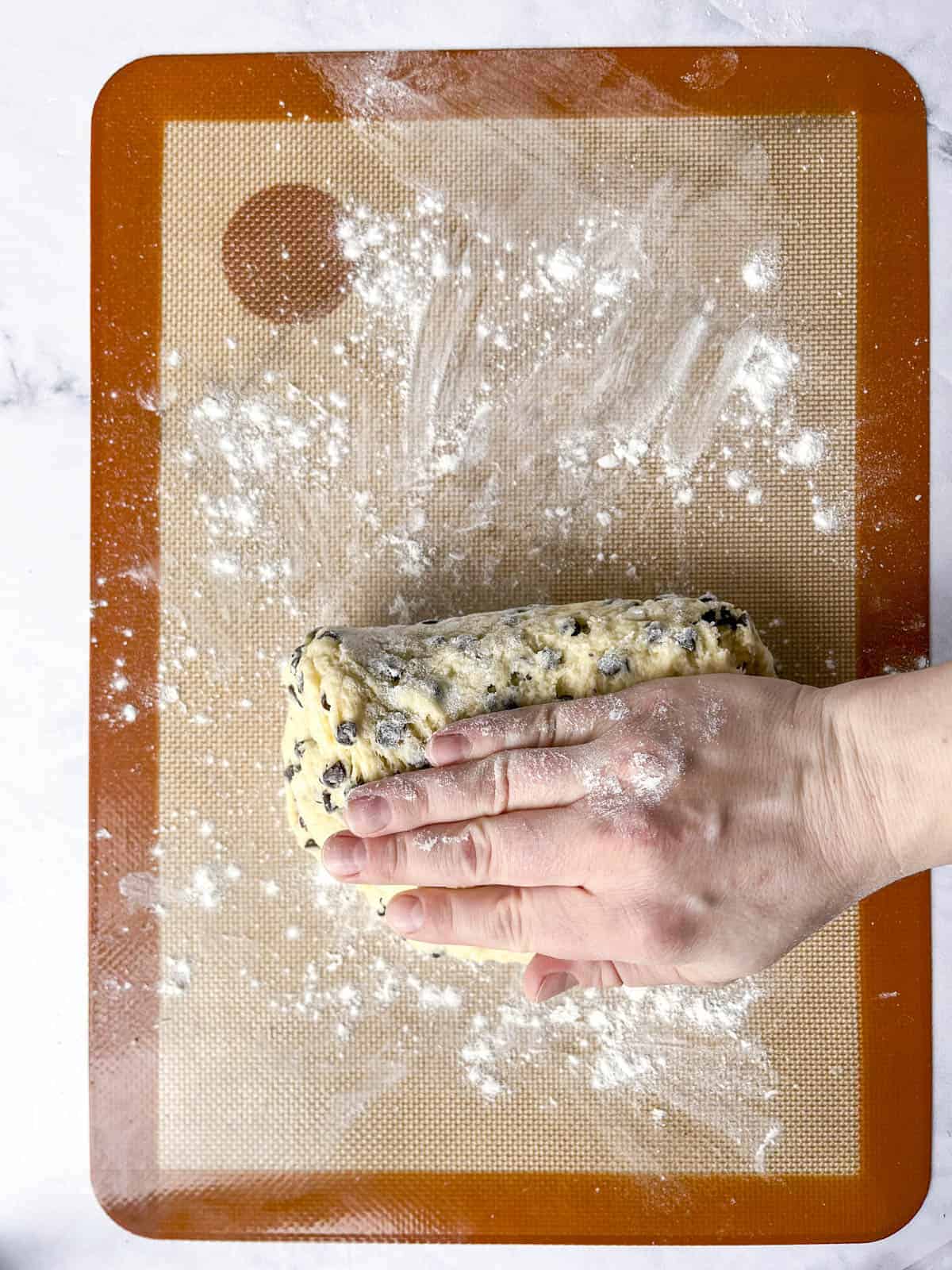
- Lamination (folding the dough to create flaky layers!): Fold the dough in half, press it down slightly, then turn the dough 90 degrees and fold in half again. Repeat this folding and turning process 4-5 times.
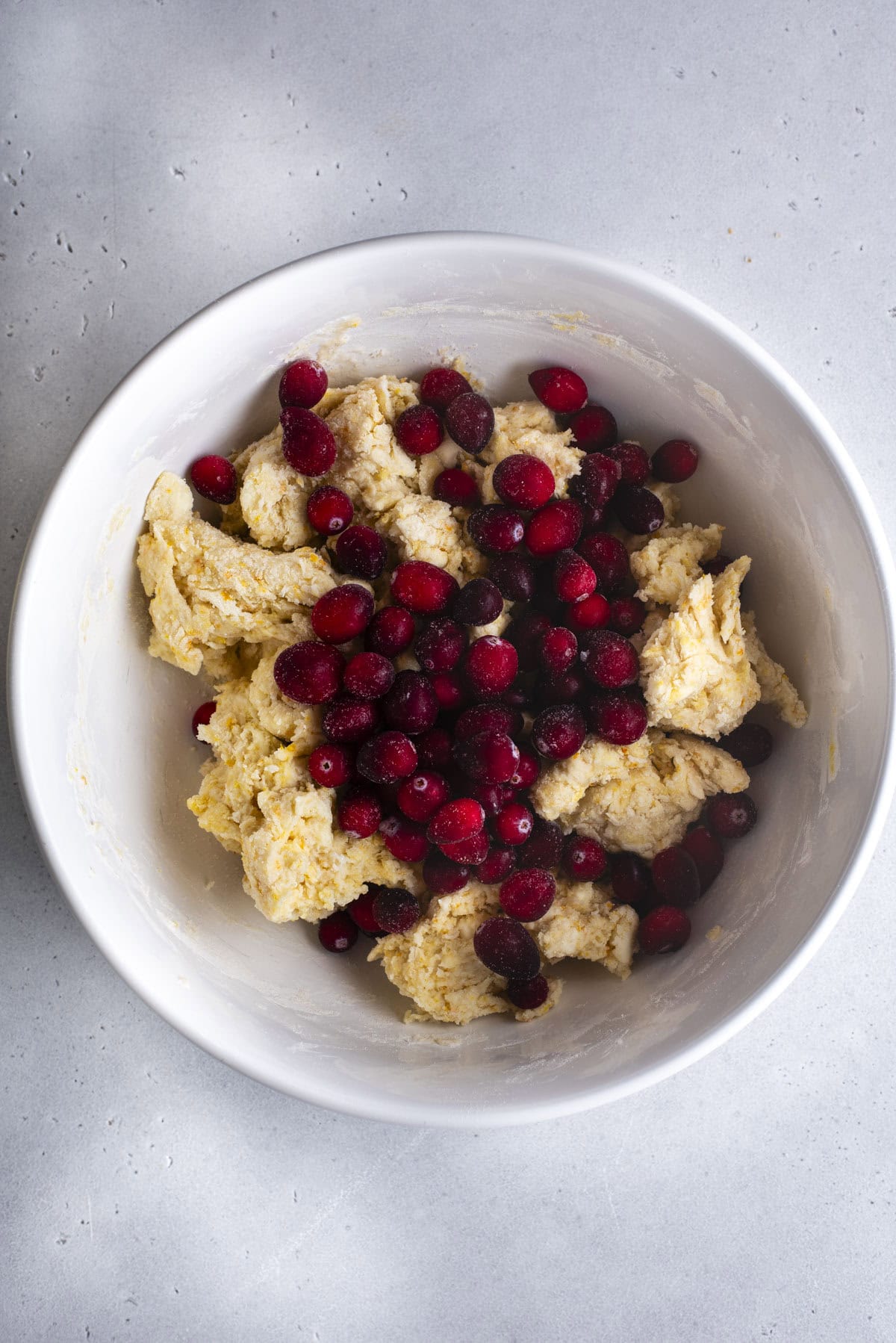
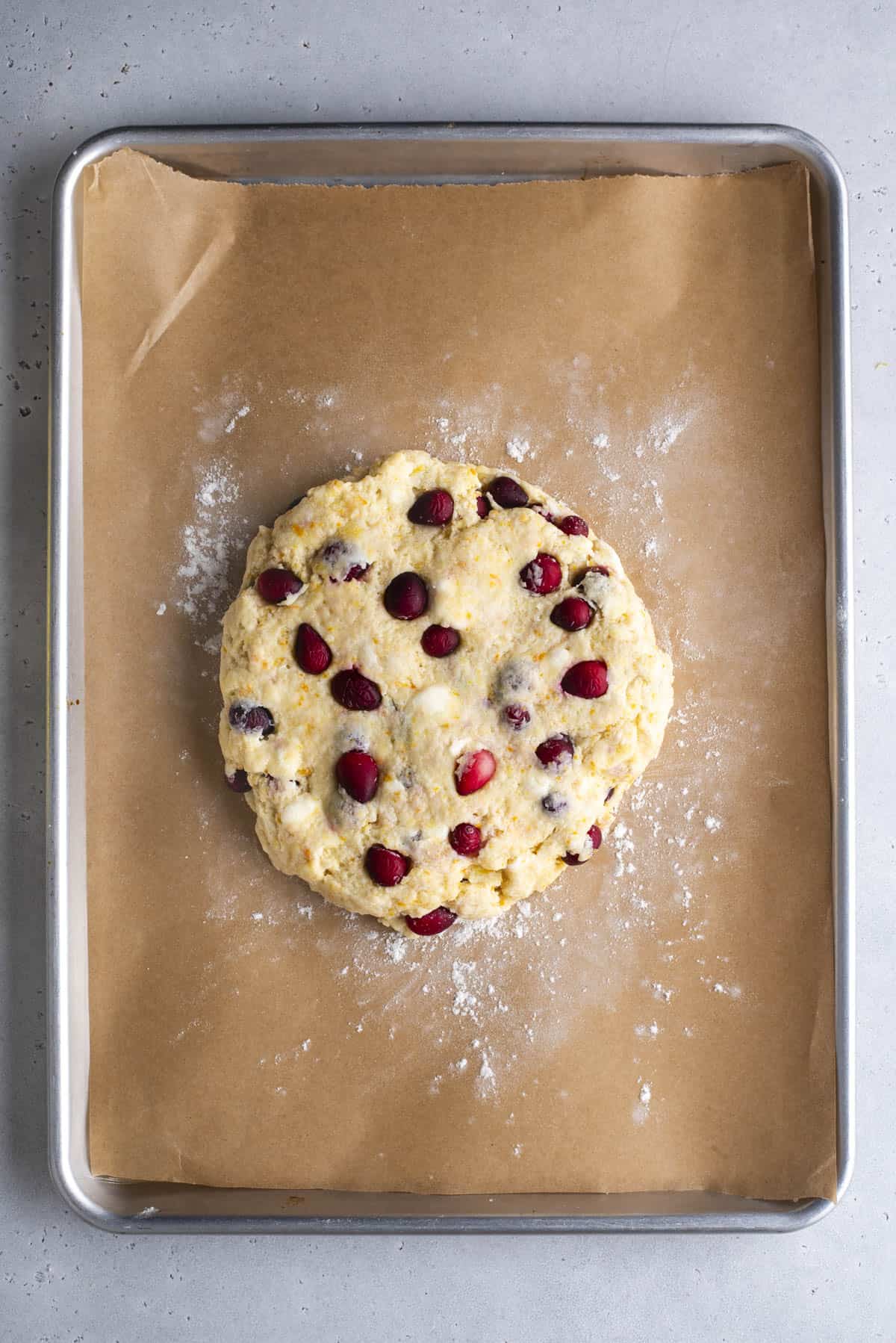
- Shape and chill dough: Shape the dough into a 8-10 inch disc that is about 1.5 to 2 inches tall. Refrigerate the scone in a disc for 5-10 minutes.
- Cut dough: Use a knife or pizza cutter to cut the scones into 8 equal wedges.

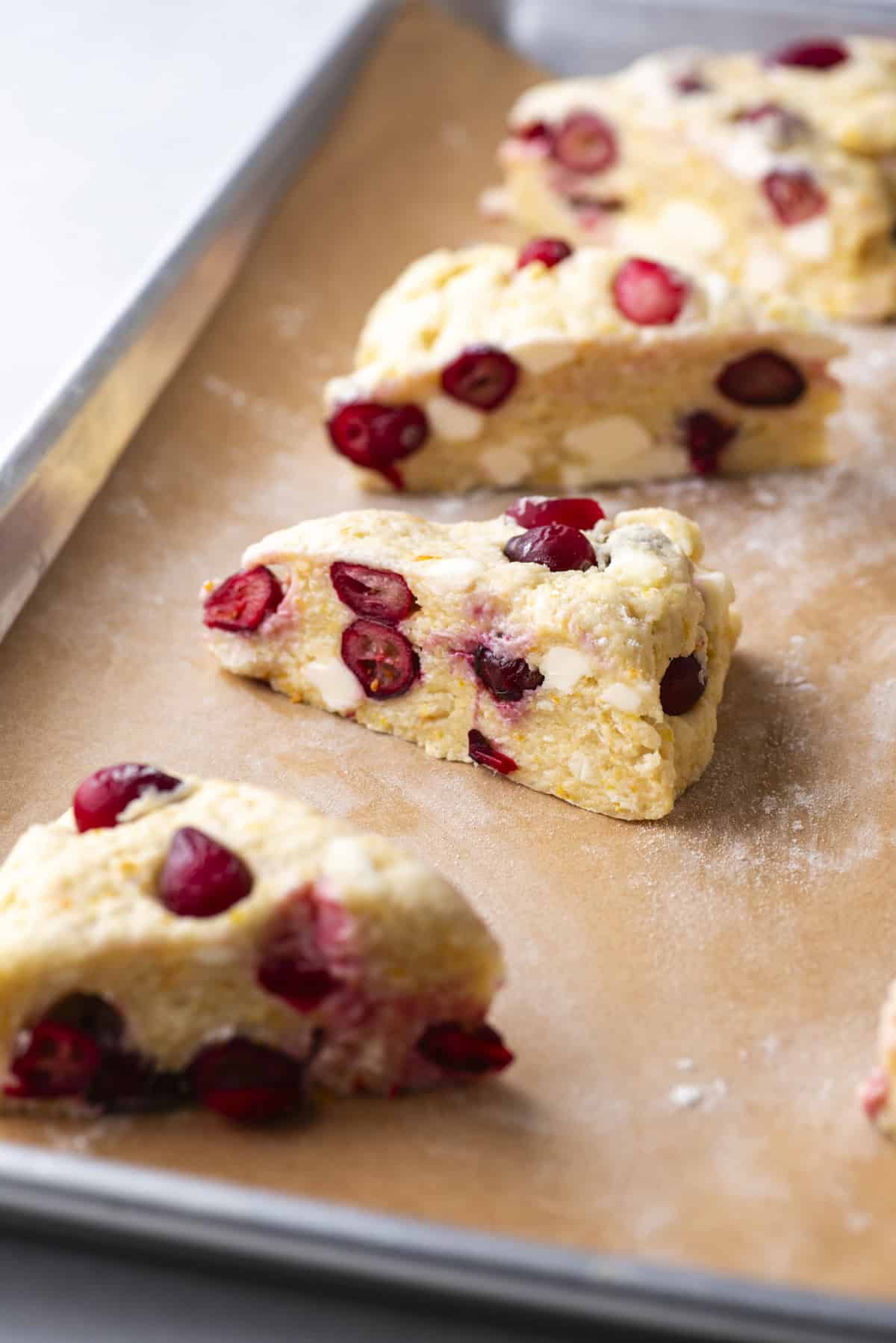
- Prep scones on baking sheet: Place the scones 2-3 inches apart on a baking sheet that’s lined with a silicone mat or parchment paper.
- Freeze the scones for 30 minutes. The last 5 minutes, preheat the oven to 400º F.
- Brush the tops of the scones with egg wash (1 large egg + 1 Tbsp water), buttermilk or heavy cream. Add coarse sanding sugar if desired.
- Bake for 20-26 minutes or until the scones are lightly golden. Allow the scones to cool.
Glaze (optional)
- Combine ingredients and drizzle: Combine the powdered sugar and 2 Tbsp of orange juice. Add more orange juice as needed to achieve your desired consistency. Drizzle over the scones.
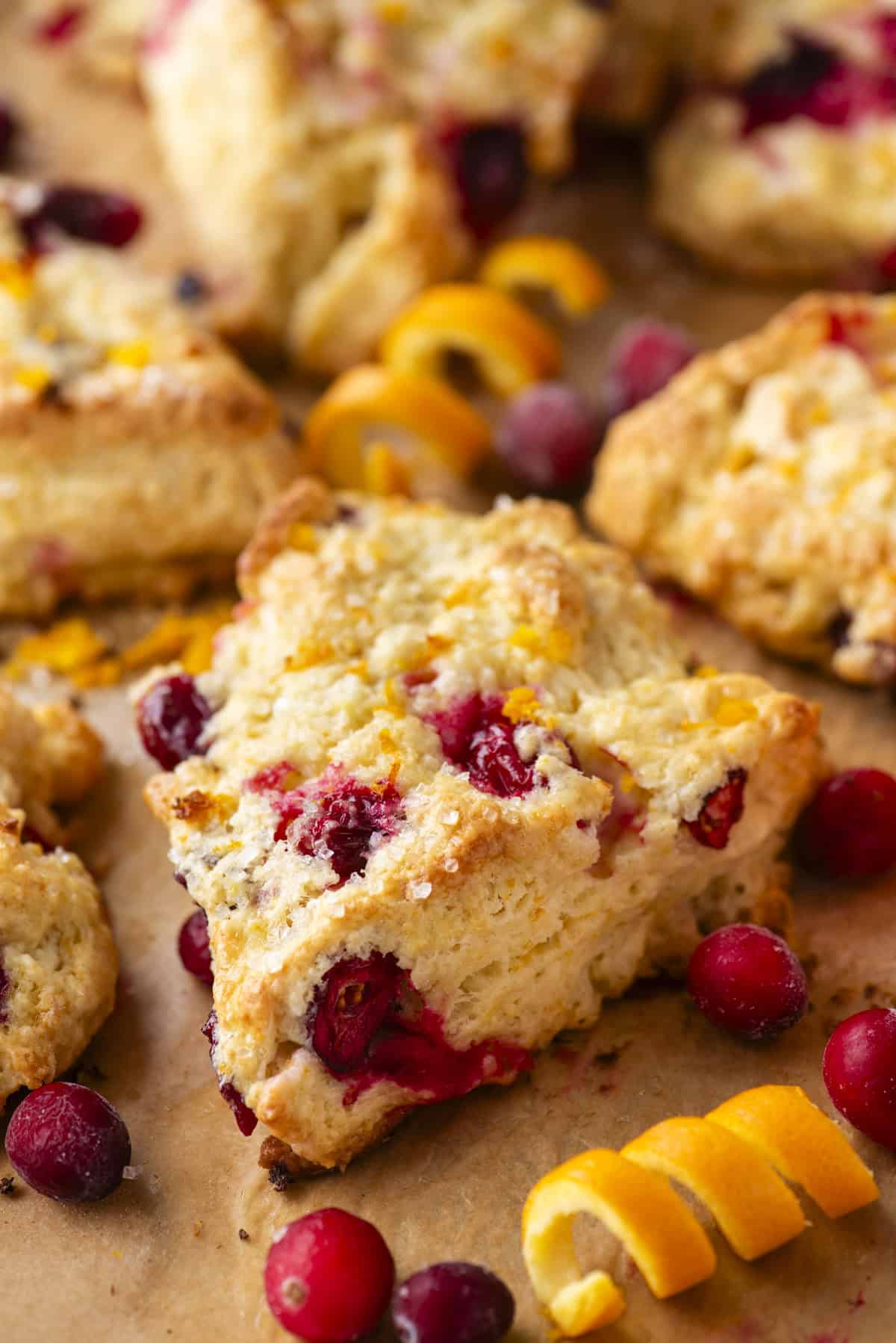
Cranberry Orange Scone Recipe Tips
For the best results, keep these helpful tips in mind:
- Start with cold unsalted butter: Cold butter is essential for the perfect scone texture. Cube the butter and place it in the freezer before mixing it into your dough.
- Don’t skip freezing the dough: Chilling the scones before baking helps them hold their shape, reduces spreading, and improves texture by keeping the butter solid. Because scones are delicate, freezing helps solidify the fat in the dough. When that cold butter hits the hot oven, it creates steam—resulting in tender, flaky layers.

How to Make Gluten Free Scones
I’ve also made this recipe with gluten free flour with awesome results! I recommend King Arthur’s Gluten Free Measure for Measure Flour. Use it as a one for one substitute for regular flour.
How To Make Tall, Flaky Scones
Lamination, which is the process of folding the dough, helps to create tall, flaky scones!
Lamination works by sandwiching layers of butter between layers of dough. During baking, the butter melts and creates steam, which separates the layers of dough, resulting in a flaky texture.
The process of laminating scones is actually very easy! Once the dough is mixed together, fold the dough in half, press it down slightly, then turn the dough 90 degrees and fold in half again. Repeat this folding and turning process 4-5 times.

How to Store Orange Cranberry Scones
Let the scones cool down fully before storing—packing them up while they’re still warm can lead to condensation, which makes them soggy. Once cooled, place them in an airtight container or a resealable bag and keep them at room temperature in a cool, dry spot. They’ll stay fresh for 1 to 2 days. Avoid refrigerating, as it tends to dry them out.
If you’d like to keep them longer, scones freeze well for up to a month. When you’re ready to enjoy them, just let them thaw at room temperature.
Cranberry Orange Scones Recipe FAQs
The best butter for scones is cold, unsalted, high-quality butter. Unsalted butter lets you control the salt content in the recipe.
Chilling scones before baking helps the dough hold its shape and promotes a flaky texture by keeping the butter cold. It also prevents the scones from spreading too much and ensures a light, tender result.
Resting scones for about 30 minutes before baking is ideal. This allows the dough to chill, helping the butter stay cold and improving the texture and rise of the scones.
More Baked Goods Recipes

Tap stars to rate!
Cranberry Orange Scone
Ingredients
- 2 ½ cups (300g) all-purpose flour
- ½ cup (99g) granulated sugar
- 1 Tbsp baking powder
- ½ tsp salt
- 1 Tbsp orange zest, about 2 oranges
- ½ cup (113g) cold unsalted butter, cubed
- ½ cup (118ml) buttermilk
- 1 Tbsp orange juice, freshly squeezed
- 1 large egg
- 1 cup (99g) fresh or frozen cranberries, or dried cranberries, do not thaw frozen cranberries
Glaze, optional
- 1 cup (113g) powdered sugar
- 2-3 Tbsp orange juice

Instructions
- In a large mixing bowl combine the flour, granulated sugar, baking powder, salt, and orange zest. Add in the cold, cubed butter and use your hands or a pastry cutter to cut in the butter until pea sized amounts of butter remain.2 ½ cups (300g) all-purpose flour, ½ cup (99g) granulated sugar, 1 Tbsp baking powder, ½ tsp salt, 1 Tbsp orange zest, ½ cup (113g) cold unsalted butter
- Create a well in the center of the flour mixture. Add the buttermilk, orange juice, and egg. Use a spatula to gently combine until the dough is thick and sticky. Gently stir in the fresh or frozen cranberries (do not thaw), or dried cranberries.½ cup (118ml) buttermilk, 1 Tbsp orange juice, 1 large egg, 1 cup (99g) fresh or frozen cranberries
- On a silicone mat or kitchen counter, gently knead the dough, until all the flour is incorporated.
- Add 1-2 additional tablespoons of flour if the dough is too sticky.
- Lamination (folding the dough to create flaky layers!): Fold the dough in half, press it down slightly, then turn the dough 90 degrees and fold in half again. Repeat this folding and turning process 4-5 times.
- Shape the dough into a 8-10 inch disc that is about 1.5 to 2 inches tall. Refrigerate the scone in a disc for 5-10 minutes.
- Use a knife or pizza cutter to cut the scones into 8 equal wedges.
- Place the scones 2-3 inches apart on a baking sheet that’s lined with a silicone mat or parchment paper.
- Freeze the scones for 30 minutes. The last 5 minutes, preheat the oven to 400º F.
- Brush the tops of the scones with egg wash (1 large egg + 1 Tbsp water), buttermilk or heavy cream. Add coarse sanding sugar if desired.
- Bake for 20-26 minutes or until the scones are lightly golden. Allow the scones to cool.
Glaze, optional
- Combine the powdered sugar and 2 Tbsp of orange juice. Add more orange juice as needed to achieve your desired consistency. Drizzle over the scones.1 cup (113g) powdered sugar, 2-3 Tbsp orange juice

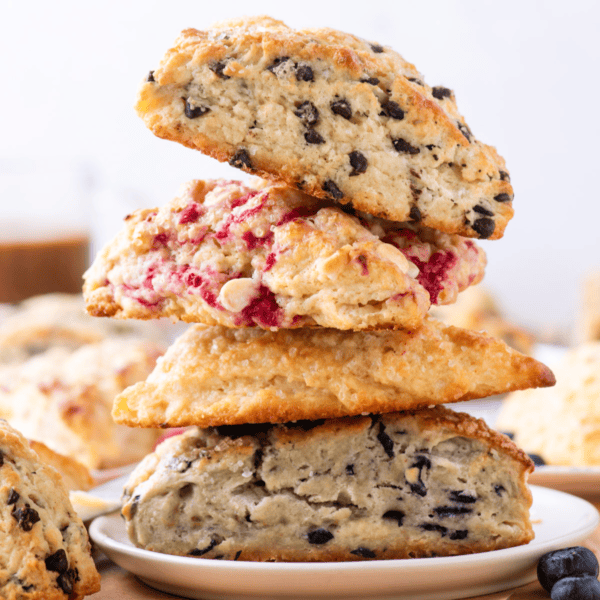









Delicious! Loved these scones and flavor and texture. Definitely best the first day.
These scones are amazing! Thank you for sharing your delicious recipes. I will definitely be making these again. I want to keep them all to myself, but I already promised to share them with family 🤣
This is my third scone recipe from Beth that I have tried. Everyone loved them! I think she is right – lamination is the key. Each time I hve made scones they have turned out better than the previous time. I actually saw the flaky layers this time! Such an easy and delicious recipe!
Have you tried freezing them before baking? I’m looking to bake a batch and cook as needed so they are fresh
Yes! In the instructions I recommend freezing for 30 minutes before baking!
These scones are the very best I have ever made. So it’s obviously worth the trouble of following the instructions to the letter! Thank you 😁